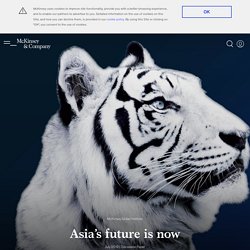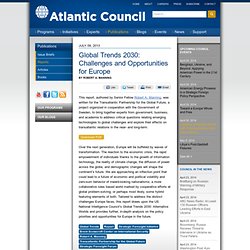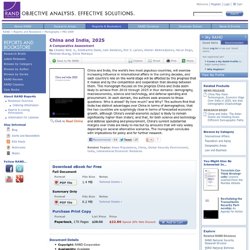

Asia’s future is now. For years, Western observers and media have been talking about the rise of Asia in terms of its massive future potential.

But the time has come for the rest of the world to update its thinking—because the future arrived even faster than expected. One of the most dramatic developments of the past 30 years has been emerging Asia’s soaring consumption and its integration into global flows of trade, capital, talent, and innovation. In the decades ahead, Asia’s economies will go from participating in these flows to determining their shape and direction. Indeed, in many areas—from the internet to trade and luxury goods—they already are.
The question is no longer how quickly Asia will rise; it is how Asia will lead. Of course, it is hard to generalize about such a vast swathe of the world, spanning myriad languages, ethnicities, and religions. The common thread across this diverse region is an upward trajectory across key economic and social indicators. Section 1 Asia is transforming trade. Global Trends 2030: Challenges and Opportunities for Europe. July 09, 2013 This report, authored by Senior Fellow Robert A.

Manning, was written for the Transatlantic Partnership for the Global Future, a project organized in cooperation with the Government of Sweden, to bring together experts from government, business, and academia to address critical questions relating emerging technologies to global challenges and explore their effects on transatlantic relations in the near- and long-term. Download PDF Over the next generation, Europe will be buffeted by waves of transformation. The reaction to the economic crisis, the rapid empowerment of individuals thanks to the growth of information technology, the reality of climate change, the diffusion of power across the globe, and demographic changes will shape the continent’s future. EO91_SC - 50405107. Australia in the Asian Century. The Key To Asia’s Future. With Western economies facing serious challenges, regional cooperation, greater intra-Asia trade and development will define the region’s future.

By Véronique Salze-Lozac’h, Nina Merchant-Vega, Katherine Loh, and Sarah Alexander for The Diplomat January 18, 2013 Facebook0 Twitter0 Google+1 LinkedIn0 Over the last several decades, Asia has become increasingly integrated with the rest of the world, its rapid development driven largely by exports to the United States and European Union (EU). Currently, over half of world trade takes place between members of regional trade agreements, and Asia is no exception. Regionalism, not Protectionism, Can Help Mitigate Global Uncertainty In fact, Asia has reason for optimism about the capacity of regional trade to compensate for weak markets in the U.S. and the EU and to reduce vulnerability to external shocks.
On the other hand, progress on SAARC’s goal of a South Asian Economic Union by 2020 remains relatively slow. Asia 2050: Realizing the Asian Century - AsianDevelopmentBankreport_asia-2050.pdf. 8 Huge Trends That Define The Future Of Asia. Frost & sullivan Asia Pacific Mega Trends. Australia in the Asian Century. Untitled - WEF_Scenario_IndiaWorld2025_Report_2010. Australia in the Asian Century White Paper - australia-in-the-asian-century-white-paper.pdf. ASEAN’s Future and Asian Integration. BAKU13_Report. China and India, 2025: A Comparative Assessment. China and India, the world's two most populous countries, will exercise increasing influence in international affairs in the coming decades, and each country's role on the world stage will be affected by the progress that it makes and by the competition and cooperation that develop between them.

This monograph focuses on the progress China and India seem likely to achieve from 2010 through 2025 in four domains: demography, macroeconomics, science and technology, and defense spending and procurement. In each domain, the authors seek answers to these questions: Who is ahead? By how much? And Why?